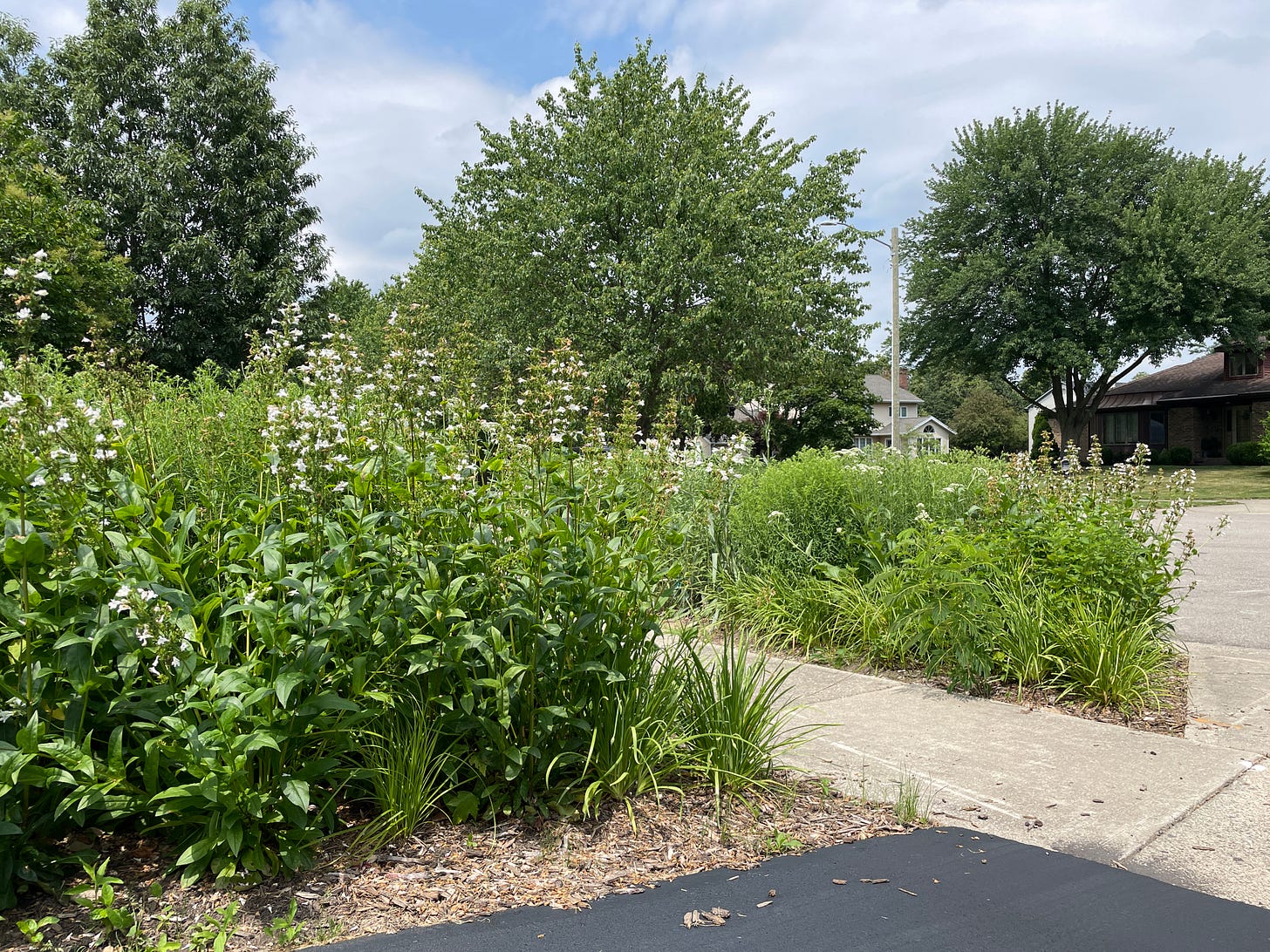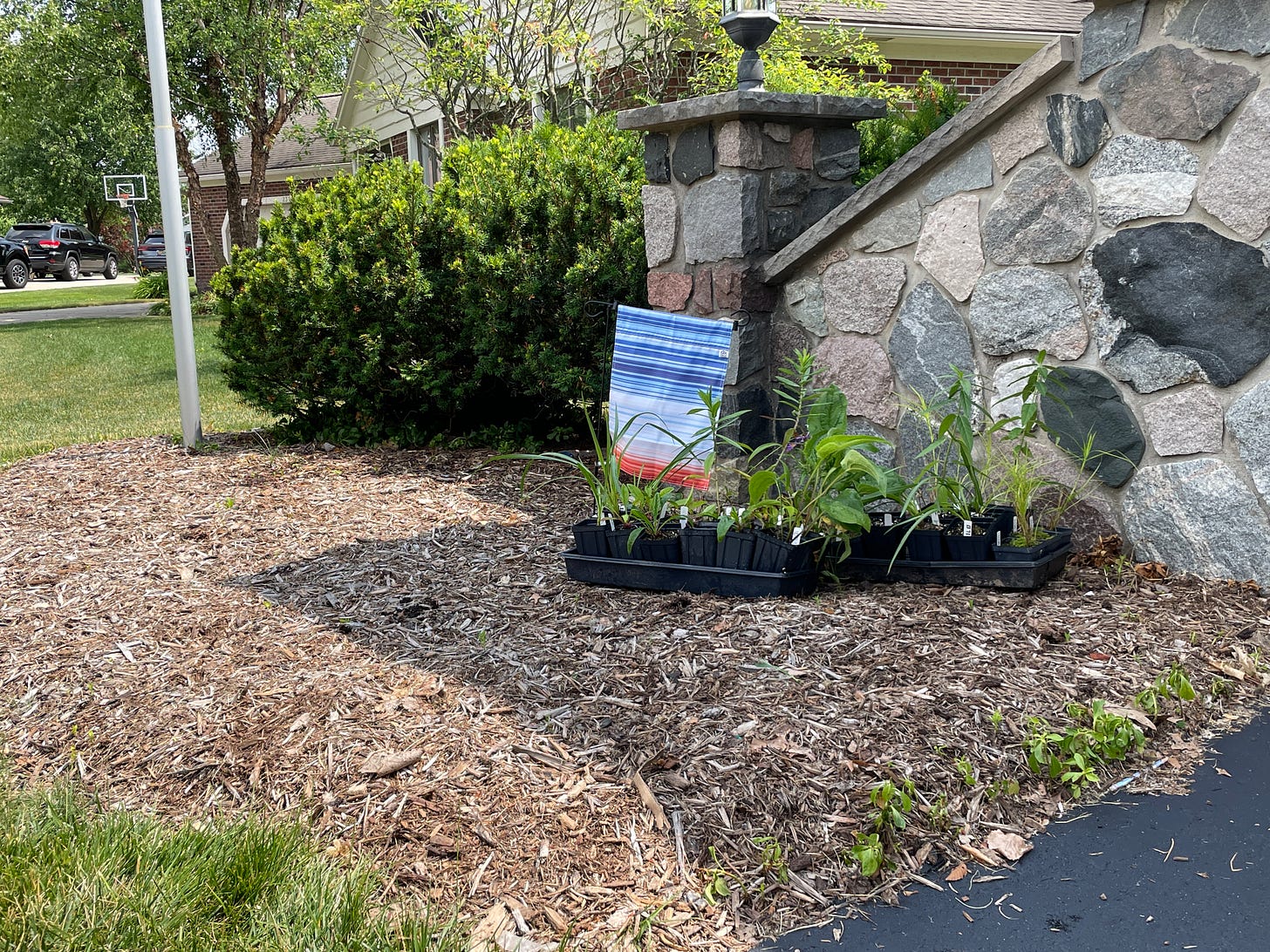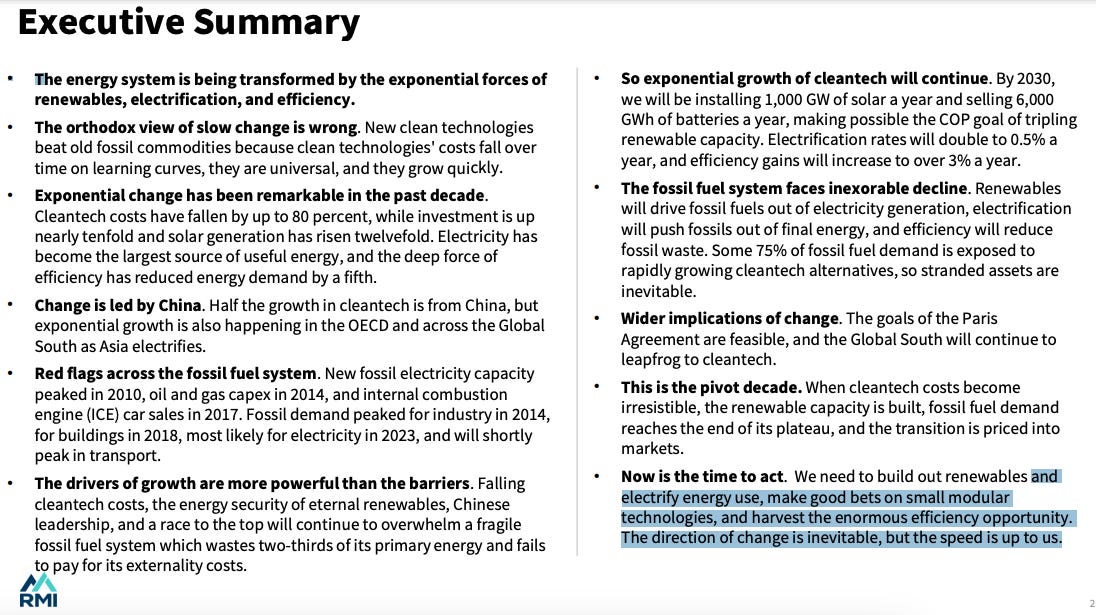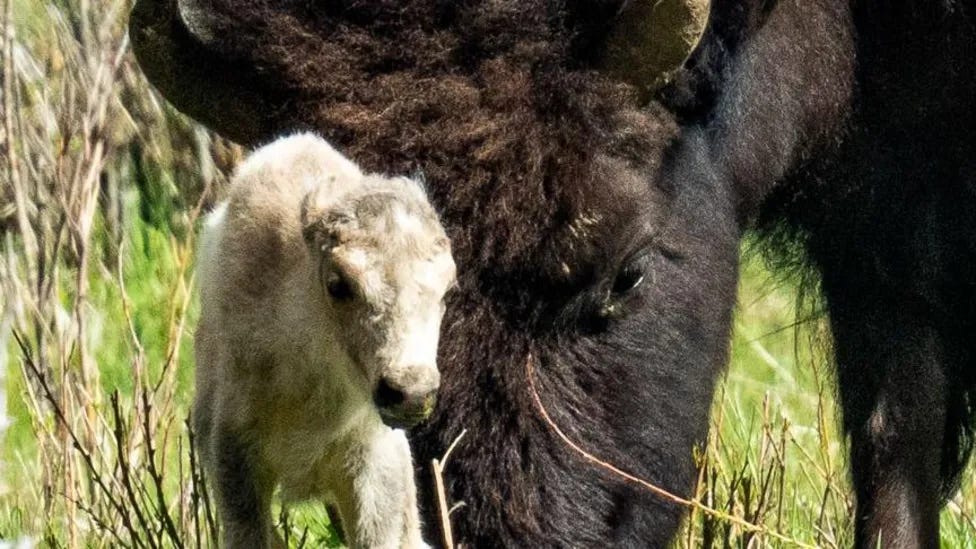Refugia Newsletter #70
Good energy transition numbers, Midwest manufacturing, state climate plans, Indigenous leadership, shark movies, sea cucumbers, and a white bison calf
Refugia News
It’s been wonderful to be back home in Michigan after our travels in May and early June. Yes, we’ve had some hot weather here this week, but not nearly as hot as some places in the US and around the world. Please take heat danger seriously if you live in a hot zone right now!
This weekend, I’ll be futzing around in my yard, trying to deal with all the tasks I left undone while I was away. Most importantly, I’ll be putting in another native garden to complement the bigger one we created last year. Look at how our main front-yard refugium is doing, after just one season!
Loving that foxglove beardtongue, which blooms first.
Last year, I prepared another spot nearby in order to create even more front-yard native areas. The new spot used to be a patch of pachysandra, which is nice enough but doesn’t do much for our neighborhood ecosystem. So I used the cardboard method to prepare the bed. To use the cardboard method, you weed-whack existing plants down to the nub and layer cardboard down over top. Then you wet the cardboard, add a layer of mulch, then a layer of compost, then more mulch. I’ve let the spot “cure” since last summer and now we’re ready to go, with baby native plants .
You can see that pachysandra is not easy to get rid of. Also, note my little climate stripes flag. June 21 is “show your climate stripes” day. For more on climate stripes, check out Katharine Hayhoe’s newsletter from yesterday.
Transforming parts of your yard into a native garden is a small but important way to promote healthy biodiversity, support insect pollinators, and feel a sense of agency. Also, it’s fun and satisfying to help plants grow. For more information on the why and how, check out Homegrown National Park’s website. If you don’t have a yard, you could still create a native planting with a team through your house of worship or workplace—maybe there’s some lawn or random corner of the property no one really needs, just waiting to be transformed.
This Week in Climate News
I’ll cover a couple news stories first, then we’ll summarize a whole lotta good news numbers and charts for the deep dive. Ready? Here we go!
Danger season. Yes, it’s been very hot all over the northern hemisphere. Is there any relief in sight? Well, maybe. Eventually. A recent article in The Atlantic by Marina Koren explains that in the last year or more, El Niño has compounded with climate change to raise temps on land and in the ocean. El Niño is now dissipating, which should bring some relief as we shift into a La Niña stage:
La Niña should eventually lower the planetary thermostat, Michael McPhaden, a senior scientist at the National Oceanic and Atmospheric Administration who studies the twin phenomena, told me. But a worrying amount of climate chaos still awaits us as La Niña asserts itself in the next several months, and the relief it may bring will be only temporary in the grand scheme of our warming world.
Additionally, La Niña brings its own troubles to some regions: the US Eastern Seaboard, Gulf Coast, and Caribbean regions, for example, can expect an even more intense hurricane season.
Midwest clean energy manufacturing boom. The Midwest has a long manufacturing legacy, of course, and it looks like clean energy industry will revive that legacy at roaring speed. An article by Kristoffer Tigue in Inside Climate News explains how the Inflation Reduction Act’s tax incentives for clean energy projects have resulted in huge amounts of private investment in the Midwest:
Midwestern states have received about $30 billion dollars in private investments to boost domestic production of electric vehicles, batteries and equipment for solar and wind farms, according to a monthly tally of funding announcements kept by energy think tank E2.
That’s about a quarter of the $123 billion in capital investments that have gone to 40 states and Puerto Rico.
State climate plans. How are states organizing their climate ambitions? Well, one way to answer that question is to analyze the climate plans states submitted in March to the EPA so that they can qualify to put their bucket under the spigot of federal IRA money. The Rocky Mountain Institute published an initial analysis of these state plans:
Millions of dollars are about to flow to states to help them tackle their unique local climate challenges. The Climate Pollution Reduction Grants (CPRG) program is one of the largest buckets of direct funding within the Inflation Reduction Act (IRA), providing $5 billion to states, municipalities, Tribes, and other governments to reduce climate pollution. The first phase of the program, the planning grants, put $250 million in state and local governments’ hands to conceive of their clean energy future. And nearly every US state, along with D.C. and Puerto Rico, put their hand up for this tremendous opportunity by submitting a Priority Climate Action Plan (PCAP, or Climate Plan) to the Environmental Protection Agency (EPA) just last month. [emphasis original]
You can read the analysis of the 6,795 pages of plans if you like. One thing I found amusing: a couple states (they didn’t name names) did not follow all the instructions for their climate plans and left some required parts out:
Per EPA guidance, the Climate Plans had to include four required “elements” or components: a GHG inventory, quantified measures, an analysis of benefits to low-income and disadvantaged communities (LIDACs), and a review of the state’s authority to implement the included measures. The majority of plans (45) included all four elements, while two states were missing one or more.
As a professor, I can tell you: there are always a couple students who do not complete the whole assignment.
Image credit: rmi.org.
Corrections and updates. Last time, I wrote about the new president of Mexico, Claudia Sheinbaum, and referred to her as a climate scientist (as many news stories had done). Dr. Katharine Hayhoe, however—who is indeed a climate scientist—pointed out in her newsletter that Sheinbaum is not actually a climate scientist. She has a Ph.D. in energy engineering. Related, but not the same. I appreciate the importance of precision on this point.
Good news update about the EU ecosystem restoration law I wrote about in newsletter #62. It passed! For a while, it was held up at the EU Council stage, but due to a lot of intense coalition building as well as a change of heart from the Austrian Green climate minister—whose yes vote got her in big trouble with the Austrian chancellor—the EU has passed the law that will “oblige member states to restore at least 20% of land and sea habitat in poor condition to a good condition by 2030, increasing to 60% by 2040 and 90% by 2050.” The vote margin was razor thin, and the whole process sounds like it was very dramatic.
Deeper Dive
The transition to clean energy is happening. The only question is how fast. That’s the bottom line for a lot of good numbers reported by some key data-crunching groups in the last few weeks. The main report the climaterati are talking about is this one from the Rocky Mountain Institute. (Another shout-out to RMI this week!)
After reading analyses of the report and trying to figure out how to convey the information to you succinctly, I finally decided to just screen-shot the report’s executive summary for you:
I know the type is small, but I’ll draw out a few highlights to further illustrate those main points.
I like this graphic, because it focuses on how pessimistic predictions have turned out to be entirely false, and even the optimists have been surprised by the speed of the energy transition.
The report is a full of slides with large swooshing arrows going upward, visualizing the breathtaking speed of change. This one, which follows on slides titled “Cleantech costs have fallen rapidly” and “Capital has poured into cleantech,” shows the astonishing amount of growth in renewable energy generation and storage. (Note: Is cleantech one word now??)
The report offers numerous reasons that all this will continue. Renewable energy is cheaper and more efficient than fossil fuels, we all want better energy security, and since China is leading in the race, we will all keep scrambling to keep up. Plus: climate change feels more and more threatening, driving the urgency.
Will it be enough, though? I appreciate this graphic in response to that question:
We are in the pivot decade. And we need to make the “faster” choice, not just the “fast” choice. As Bill McKibben summarized in his newsletter:
At the moment, we’re on a path to double renewable power by the end of the decade. That’s great. But we need to triple renewable power by the end of the decade to meet even the modest targets we set at Paris for holding the temperature in check.
Fortunately, clean energy investments will double fossil fuel investments this year, according to the International Energy Agency. From Reuters: “Combined investment in renewable power and grids overtook the amount spent on fossil fuels for the first time in 2023. ‘For every dollar going to fossil fuels today, almost two dollars are invested in clean energy,’ said IEA Executive Director Fatih Birol.” That’s $2 trillion for clean energy and—unfortunately, still $1 trillion for fossil fuels.
Anyway, it’s all a race. You’re doing a good thing right now toward helping with that race, just by staying informed.
Refugia Sighting
I’m offering some gratitude today for the many indigenous peoples around the world who have persisted in stewarding land and water well, despite every obstacle, prejudice, and injustice. They are the keepers of many refugia on this planet. In fact, a 2022 article on Statista quantified how indigenous peoples’ care and influence are crucial:
Despite the fact that indigenous peoples make up around 15 percent of the world’s extreme poor and just five percent of the global population, they are protecting 80 percent of the world’s remaining biodiversity, according to data cited in Australia’s newly released 2021 State of the Environment report.
I see this statistic floated all the time. But this month’s issue of National Geographic brings specific stories to illustrate how this looks in practice, with features on indigenous cultural achievements, voices, and stewardship work. Of the five stories about indigenous land/water stewardship, I especially enjoyed the one about the Helen Reef Resource Management program, based on traditional Hatohobei stewardship of a reef in Palau. The story describes how, in 2020, indigenous reef managers succeeded in holding off a Chinese poacher vessel until the U.S. Coast Guard could arrive and bring the poachers to justice. (The poachers were after sea cucumbers, among other things.)
Now imagine 500 pounds of these things on the poachers’ boat. Image credit: CC Gourdeau/Tastingtable.com
As Secretary of the Interior Deb Haaland writes in another article in the issue, indigenous knowledge and commitment are essential for repairing biodiversity all over the world, including in the US. She writes about partnering with Indigenous peoples to create wise management strategies:
Successful co-stewardship ensures that Indigenous knowledge—a deep understanding of the land and wildlife gained over millennia—is put to use as one of the most essential strategies to tackle the climate crisis.
Image credit: Erin Braaten, Dancing Aspens Photography/bbc.com.
Could history be turning a page when it comes to honoring Indigenous wisdom? Well, the bison might be trying to tell us something about that. According to BBC news,
An incredibly rare white bison calf has been photographed in Yellowstone National Park, exciting Native American tribes who view it as a religious sign heralding major change.
The article goes on to explain the possible meanings of this event:
The birth of a white buffalo is a sacred event for many Native tribes of the Great Plains, including the Lakota people, who believe that it relates to a time around 2,000 years ago when food was scarce and the bison were rarely seen.
The Lakota legend tells of a beautiful woman who appeared and delivered the gifts of a sacred pipe and bundle to the people.
The woman told them she would return to restore harmony in a troubled world, and then rolled on the ground four times, changing colour each time before becoming a white buffalo calf.
Her departure led the bison to return, and white buffalos are now seen as a sign that prayers are being heard and that change is coming.
So… good change or bad change? Well, maybe that’s up to us…
Books and Media Corner
A new feature for this newsletter? Maybe. What do you think?
Let’s start with the Hollywood Climate Summit. I featured Anna Jane Joyner’s climate-story consulting business, Good Energy, in newsletter #67, so it’s cool to see that some people in the film industry are taking seriously the call to tell more accurate climate stories—and trying to support their peers in doing the same.
According to Shayna Berglas of the Pique Action newsletter:
At its core, the Hollywood Climate Summit is about energizing climate optimism while deepening climate literacy. By connecting climate stories with acquisition and development opportunities, the Summit improves the pipeline for climate content to reach audiences. It challenges the expectations of what a climate story can be, amplifying a variety of genres, plotlines, and formats that are commercially viable and entertainment-forward.
Speaking of climate movies, I’m thrilled to learn that Netflix has released Under Paris, a French-made movie about—get this—a giant, mutated, and people-hungry shark that ravages the Paris Olympics. As Arielle Samuelson of the Heated Substack points out, real sharks aren’t growing huge and maniacal because of climate change (as the movie posits), but other animals are indeed mutating in various ways to tolerate higher temperatures. Never mind. The film is a thriller, a satire, and a warning about climate change. Kind of a combination of Jaws, Don’t Look Up, and every disaster movie I’ve ever loved. Clearly my plans for the weekend are now set.
More on strategic climate communications: I commend to you this excellent interview that David Marchese did with Dr. Ayana Elizabeth Johnson in the New York Times. Johnson is a marine biologist as well as one of those serious scientists who is also a skilled climate communicator. In the interview, she discusses the role of both grim and hopeful communications in keeping people motivated to work for change. It’s especially important right now, she argues, to help people imagine a good future. Her own book, coming out in September, is called What If We Get It Right? I’ve already pre-ordered my copy.
Finally, if you are involved in ecosystem work of any kind—or if you’re just interested in it—I highly recommend the new book by my colleagues Gail Heffner and Dave Warners, Reconciliation in a Michigan Watershed: Restoring Ken-O-Sha. Gail and Dave present both and argument for and a case study of “reconciliation ecology.” This kind of restoration work requires a deep dive into history and sociology as well as geology, hydrology, and biology—all in order to rebuild not only ecosystems, but also the broken relationships among people and between people and land. Broken and abusive relationships, after all, led to the damage in the first place. Gail and Dave use their work with the Plaster Creek Stewards in Grand Rapids to demonstrate how reconciliation ecology works. And importantly for people of faith, their approach is motivated by a wholistic, faith-based understanding of what restoration can mean. I got to blurb the book, so they sent me this graphic to share with you:
Whew! Well, that’s all for now. Thanks for reading, and until next time: be well.
As always, bold emphasis in quotations is added unless otherwise indicated.














I just finished Dave and Gail’s book and it was fascinating-from the history of how the land was originally cared for to the destruction of the environment by the white settlers to the current efforts of ecology restoration. Highly recommended.
I like the Book and Media addition! I’m a podcast nerd, so if you could also point us to current episodes to listen to, that would be much appreciated!